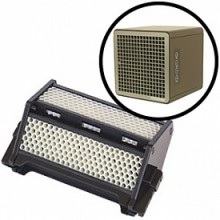


HEPA filters for air purifiers are essential for removing microscopic pollutants and improving indoor air quality in homes and workplaces.
As concerns over indoor air quality grow in homes, offices, and healthcare facilities, technologies that enhance air purification have garnered increasing attention. Among the most effective tools in this arena are HEPA filters for air purifiers, renowned for their ability to trap fine particulate matter, allergens, and even pathogens. Understanding how these filters work, their advantages, and their limitations can help consumers and institutions make informed decisions about improving air quality indoors.
HEPA, or High-Efficiency Particulate Air, filters are made from a dense mat of randomly arranged fibers, typically composed of fiberglass. These filters are designed to capture particles as small as 0.3 microns with an efficiency rate of 99.97%. To put this into perspective, a human hair is approximately 70 microns in diameter, making HEPA filters capable of capturing particles more than 200 times smaller.
The standard for HEPA filters was first established by the U.S. Department of Energy for use in nuclear facilities and has since been adopted in a variety of consumer and industrial applications, including vacuum cleaners, automobiles, and especially air purifiers. Their widespread use is a testament to their performance and reliability.
The effectiveness of a HEPA filter is not based on a simple mesh structure that blocks particles by size alone. Instead, it combines several physical mechanisms: interception, impaction, and diffusion. Larger particles are caught by interception and impaction, while smaller particles such as smoke, bacteria, and some viruses are captured through diffusion as they randomly move through the filter material.
Because HEPA filters target particles in such a wide range of sizes, they are particularly useful in removing allergens like pollen, dust mites, mold spores, and pet dander, as well as fine particulate matter from combustion sources such as car exhausts and cigarettes.
Indoor air can be significantly more polluted than outdoor air, largely due to enclosed spaces allowing the buildup of contaminants. Everyday activities such as cooking, cleaning, and even using certain household products can release airborne pollutants. Add to this the infiltration of outdoor pollutants, and it becomes clear why maintaining indoor air quality is vital.
For individuals with asthma, allergies, or other respiratory conditions, clean air isn’t just a comfort—it’s a necessity. In these cases, using air purifiers equipped with HEPA filters can significantly reduce exposure to harmful particles.
In homes, HEPA filter-equipped air purifiers are commonly placed in bedrooms, living rooms, and nurseries. Their purpose is to maintain a healthy environment, particularly for vulnerable populations such as infants, the elderly, and those with compromised immune systems.
In commercial and industrial settings, especially in hospitals, laboratories, and cleanrooms, HEPA filters are essential. In these environments, maintaining a sterile and contaminant-free atmosphere is critical to operations and occupant safety.
Schools and office buildings are increasingly turning to air purifiers with HEPA filters as well, as part of broader public health strategies in response to airborne viruses and pollution-related health risks.
While HEPA filters offer numerous benefits, they are not without limitations. For example, they do not remove gases, odors, or volatile organic compounds (VOCs) unless combined with additional technologies such as activated carbon filters. Also, HEPA filters need to be replaced periodically to maintain their effectiveness, which can add to maintenance costs.
Consumers should also be wary of products labeled “HEPA-type” or “HEPA-like,” which may not meet the same stringent standards as true HEPA filters. Always look for certification details when purchasing a device.
Another consideration is the size of the room in which the air purifier is used. A filter’s efficiency can be compromised if it is used in a space larger than it is rated for. Air purifiers typically list the Clean Air Delivery Rate (CADR), which helps buyers determine the appropriate model for their needs.
The increased use of disposable HEPA filters has raised concerns about environmental sustainability. While the filters themselves are not typically recyclable due to the contaminants they collect, some manufacturers are exploring biodegradable materials and more energy-efficient purification systems.
Consumers can also play a part in sustainability by choosing energy-efficient air purifiers, disposing of used filters properly, and ensuring that devices are used only when necessary to avoid excessive power consumption.
As air purification technology evolves, hybrid systems are being developed to combine HEPA filtration with UV-C light, electrostatic precipitation, or photocatalytic oxidation. These multi-stage systems are designed to address a broader range of pollutants, including microorganisms and VOCs.
Smart home integration is another key trend, with Wi-Fi-enabled air purifiers offering real-time air quality data, automated operation, and reminders for filter replacement. These features improve user convenience while ensuring optimal filter performance.
Governments and health organizations have begun to emphasize the importance of indoor air quality more seriously. In many cities, initiatives are underway to encourage or mandate the use of air filtration in schools, public buildings, and transportation hubs.
This growing attention to air quality reflects a deeper understanding of its relationship with chronic health conditions, productivity, and even mental well-being. As awareness spreads, HEPA filters will likely remain a cornerstone technology in air purification strategies.
Selecting the right air purifier involves more than just picking one with a HEPA filter. Factors to consider include the size of the area to be purified, noise levels, energy consumption, additional filtration technologies, and ease of maintenance. Understanding these aspects can help consumers make a practical and cost-effective choice tailored to their specific needs.
For instance, a small bedroom may only require a compact unit with a moderate CADR, while a large office might benefit from a higher-capacity device with a combination of HEPA and activated carbon filters. Consulting product reviews and performance tests can also aid in the decision-making process.
